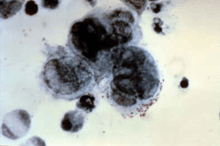Tzanck test

A positive Tzanck test, showing three multinucleated giant cells ("Tzanck cells") in center.
In dermatopathology, the Tzanck test, also Tzanck smear, is scraping of an ulcer base to look for Tzanck cells. It is sometimes also called the chickenpox skin test and the herpes skin test.
Tzanck cells (multinucleated giant cells) are found in:
The Tzanck test has been largely replaced by DFA for identification of the herpes virus [2]
Procedure
- Unroof vesicle and scrape base w/ sterile №15 scalpel blade
- Smear onto clean glass slide
- Fix w/ gentle heat or air dry
- Fix w/ MeOH
- Stain w/ Giemsa, methylene blue or Wright’s stain
- Microscopic examination using oil immersion lens. (Look for multinucleate giant cells)[3]
A modified test can be performed using proprietary agents which requires fewer steps and allows the sample to be fixed quicker.
Eponym
It is named after Arnault Tzanck (1886–1954), a French dermatologist.
References
- ↑ Folkers E, Oranje AP, Duivenvoorden JN, van der Veen JP, Rijlaarsdam JU, Emsbroek JA (August 1988). "Tzanck smear in diagnosing genital herpes". Genitourinary medicine 64 (4): 249–54. PMC 1194227. PMID 3169755.
- ↑ "The laboratory diagnosis of herpes simplex virus infections." Can J Infect Dis Med Microbiol. 2005 Mar-Apr; 16(2): 92–98. PMCID: PMC2095011
- ↑ Pettit, Normal Microbiota of the Skin, ATSU School of Osteopathic Medicine Arizona, Lecture Slides. Jan 2013.
External links
- Tzanck test - medlineplus.org.
- Definition of Tzanck test - medterms.com.
| ||||||||||||||
This article is issued from Wikipedia - version of the Wednesday, December 23, 2015. The text is available under the Creative Commons Attribution/Share Alike but additional terms may apply for the media files.